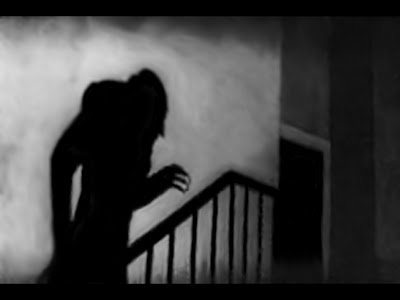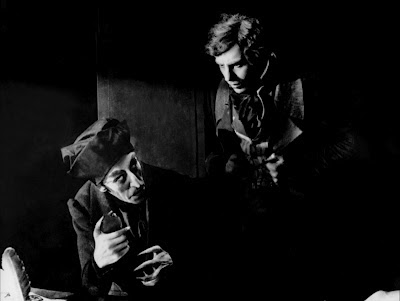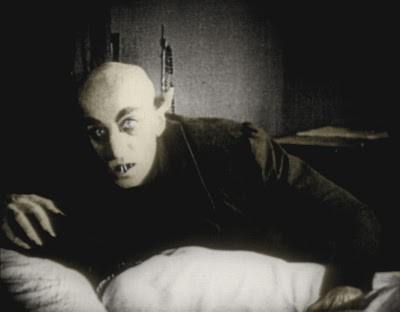Murnau's Nosferatu casts a long shadow over horror cinema. In fact, it's one of those films that has such a hugely acknowledged and accepted influence, that it makes it hard to know what one can possibly say about it that hasn't been said already. Despite its age (ninety this year!) it retains an uncanny, almost numinous aura and a hypnotic power that lulls the unsuspecting spectator into its strange spectral world.
The story begins in the relatively heimlich surroundings of Wisborg. Our hero, the unflaggingly cheery Thomas Hutter (played by the wonderfully named Gustav vov Wangenheim; think I've just found my German porn star pseudonym, if I ever need one) seems to be enjoying a life of generally cosy domestic bliss with his already-slightly-dead-looking wife (foreshadowing or too much eye-shadowing?) Ellen and some cute kittens. Obviously, such an idyllic existence could never last and soon Hutter's downright sinister boss Knock (who looks like a silent-era version of Patrick Magee, with equally wigged out facial expressions and even gnarlier eyebrows) is sending him on his merry way to Transylvania, where his incorrigible optimism is soon put to the test.
It almost goes without saying that sex is rarely far from the surface as far as vampire stories are concerned; but for some reason, it really hit me over the head watching the film again recently in tandem with Herzog's homage. I mean, come on, Ellen/Lucy has to keep the Count up all night by acquiescing to some serious necking, in order to slay the beast, so to speak.
The 1979 remake is pretty faithful to its source, for the most part, especially in terms of its strong sense of composition and pacing/rhythm. However, certain humourous touches, such as a kid playing a violin pretty damn badly and a surreal end of the world party in an abandoned town square, are pure Herzog. He also fleshes out the characters quite a bit (making the Count more sympathetic and giving the Mina Harker inspired character more to do) which is a no-brainer really when you've got such an unbelievably heavyweight acting double team as Klaus Kinski and Isabelle Adjani at your disposal (Wings of Desire's Bruno Ganz is no slouch either).
Both directors are also highly adept at bringing a documentary/travelogue feel to many scenes, arguably helping to make the eventual transition into the realms of the supernatural even more startling. Murnau, for instance, inserts footage of carnivorous plants in one scene, whilst having a character point out their similarity to vampires. And Herzog, during his film's opening credits, shows us some frankly disturbing footage of mummified cholera victims he shot in Guanajuato, Mexico. These two examples are not exactly the ideal ones to illustrate the cinema verite feel I was referring to, but they do perhaps show that even in our relatively prosaic, natural surroundings, death and dissolution are never far away.
A little bit of six-degrees-of-separation type trivia to finish: Herzog cast French surrealist renaissance man Roland Topor as Renfield (who, to be honest, annoyed the piss out of me at times with his incessant, psychotic laughter; still unnerving as well, to be fair though). This was the man who also wrote The Tenant (Le Locataire) which was later made into a cinematic black comedy-horror masterpiece by Polanski, and featured as certain Ms. Adjani, who gave the horror genre one of its greatest all-time performances in Andrzej Zulawski's Possession. If memory serves, Final Girl and everyone aboard the SHOCKtober train will be looking at both these films on October 17th and the 10th respectively. I'm sort of half-improvising my list of movies for this month as I go, but I've been eager to give these two a re-watch for a while, and this is as good an excuse as any.
For some more reviews of today's movie, take a trip to these fine blogs:










No comments:
Post a Comment